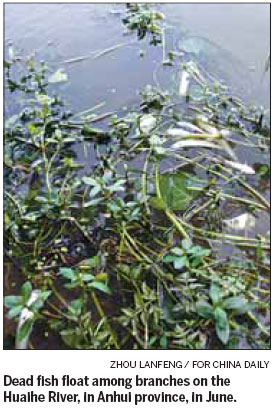 Air Forces arrive at designated area to join China-Russia drill
Air Forces arrive at designated area to join China-Russia drill
 High temperature hits Shanghai
High temperature hits Shanghai
 Old town Dali hosts int'l photography exhibition
Old town Dali hosts int'l photography exhibition
 Death toll rises to 29 in rain-related accidents across Pakistan
Death toll rises to 29 in rain-related accidents across Pakistan
 New police weapon to tackle armed suspects
New police weapon to tackle armed suspects
 Nutrica recalls Karicare infant formula in New Zealand
Nutrica recalls Karicare infant formula in New Zealand
 Sexy models in CFGP race
Sexy models in CFGP race
 Child labor still remains rampant in war-hit Afghanistan
Child labor still remains rampant in war-hit Afghanistan
 Sun Yang the star of last day at World Swimming Championships
Sun Yang the star of last day at World Swimming Championships
 |
Deformed fish
Villagers said the number of people diagnosed with cancer has been high in places along the Shaying River since the 1990s, prompting many residents to move away to escape the heavy pollution.
Factories such as a large gourmet powder manufacturer and a leather plant are the chief culprits, they said.
Wang Guoyong, a doctor in nearby Dongsunlou, said two of his patients - men in their 50s and 70s - died of liver cancer last year, while two new cases of stomach cancer and esophagus cancer were reported.
"In many rural areas, lots of people never go to hospital, so they have no idea what kind of disease they have," he said.
At least half of the deaths in his village were caused by cancer, he said.
Zhang Liujie in Liuji village said the fish in the Shaying River have even become deformed due to the heavy pollution.
"Once I caught fish from the river and was astonished when I was cooking them. Their bones had become twisted," the 31-year-old said. "I didn't dare eat them."
Villagers do not even feel safe swimming in the river.
Phoenix Weekly reported in 2009 that the groundwater in all of Shenqiu's towns had been contaminated, and that many villagers had to buy bottled drinking water. About 21 areas had become "cancer villages", where the disease had caused nearly half of all deaths, the report said.
Jin Xuewu, 45, a ship owner who transports river sand from the lower reaches in Anhui province to sell, said the situation there is even worse.
"When I went to Bengbu Tumor Hospital (in Anhui) last year, I found about 80 percent of cancer patients were from around the Huaihe River," he said.
Cleanup incomplete
Huo at Huaihe River Guardian said the government became aware of the pollution in the river in the early 1990s and has been dealing with the problem since then.
As early as 1993, a report by the State Environmental Protection Administration (now the Ministry of Environmental Protection) warned that pollutants in 82 percent of its reaches were above safe levels in low water seasons.
In July 1994, about 200 million cubic meters of polluted water were discharged upstream due to continuous rain, killing fish and causing water shortages for almost 1 million people.
The State Council issued a guideline in 1996 that required four provincial governments to clean up the Huaihe River by 2000.
More than 10 years after that deadline, the goal is yet to be achieved, Huo said, although the water quality has improved from Grade 5, the lowest level, to Grade 4, which qualifies it for landscape water though it remains undrinkable.
The amount of harmful elements in the Huaihe River is still much higher than the standard, he said, and nearby soil has been badly affected.
Huo urged authorities not to prioritize economic growth over the environment by turning a blind eye to faulty sewage discharges, nor act as an umbrella for polluters.
A Shenqiu environmental protection bureau official who did not want to be identified said the county government has shut down hundreds of small factories, including paper manufacturers and fertilizer producers, to protect the Huaihe River.
Two sewage treatment plants have been built and most industrial wastewater is now processed in line with government rules, he said.
However, the official added, the main sources of pollution - villagers' household sewage and waste from livestock farms - remain difficult to supervise.
The progress so far has done little to help allay the fears of villagers living near the river.
People are worried about their health, but they feel powerless to do anything, said Guo Xinxiang in Wafang.
"We want to file a lawsuit to claim compensation, but we don't even know who to accuse," he said.
 |
 Chinese troops of "Peace Mission - 2013" arrive at exercise area
Chinese troops of "Peace Mission - 2013" arrive at exercise area Pakistan's rain-triggered accidents claim 29 lives: media
Pakistan's rain-triggered accidents claim 29 lives: media Daily life of auctioneer in Beijing
Daily life of auctioneer in Beijing Top 10 most dangerous jobs in the world
Top 10 most dangerous jobs in the world Zhang Ziyi graces Femina magazine
Zhang Ziyi graces Femina magazine Breathtaking images of extreme sports
Breathtaking images of extreme sportsDay|Week|Month